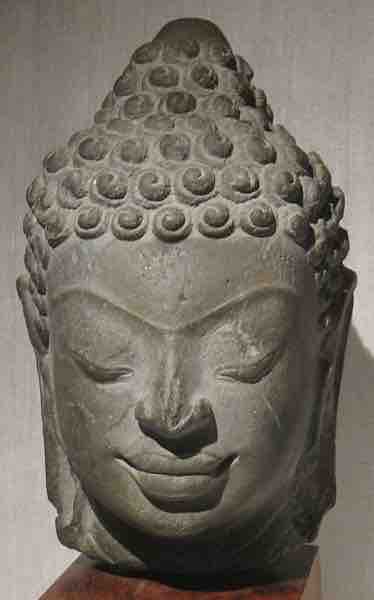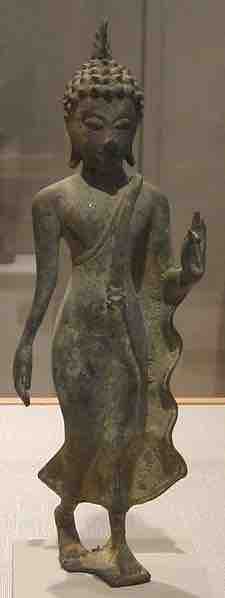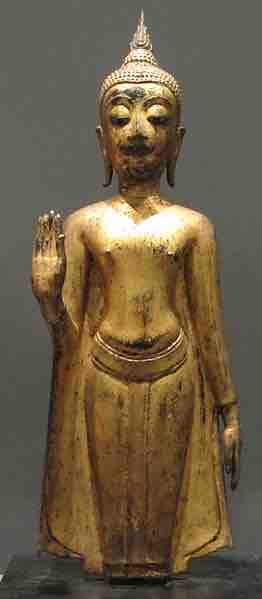Background: Traditional Thai Art
Traditional Thai art primarily consists of Buddhist art and, to a lesser extent, Hindu-influenced Thai folklore. From the 1st to the 7th centuries, art in Thailand was influenced by direct contact with Indian traders and the expansion of the Mon Kingdom, leading to the creation of Hindu and Buddhist art inspired by the Gupta tradition of India. Thai sculptures most often depict images of the Buddha and other characters from Buddhist and Hindu mythology, while Thai paintings comprise book illustrations and painted ornamentation of temples and palaces. The history of Buddhist sculpture in Thailand until the 18th century can be divided into three broad phases: the Dwaravati period, the Sukhothai period, and the Ayutthaya period.
Buddhist Sculpture in Thailand
Dwaravati Period (6th–11th centuries)
The Indian styles of the Amaravati and Gupta empires formed the basis of much of Dwaravati art, which produced both Hindu and Buddhist images, usually taking the form of monumental statues. From the 9th century onward, Mahayana influences such as the Cambodian Khmer style in the north and the Sri Vijaya style in the south became more important. Dwaravati art came to represent the Mahayana pantheon, portraying multiple creations of Bodhisattvas, or enlightened beings.
Three important styles of portraying the Buddha emerged during the Dwaravati period:
- Buddha in the Tribhanga (leaning) position, with Indian features and no aureole.
- Buddha in the Amaravati style with loosely folded legs, a continuous eyebrow, flat nose, thick lips, and a lotus-shaped aureole.
- A square-faced Buddha with a cleft chin, Khmer features, and fully folded legs, sitting on a lotus base.

Head of Buddha, Dvaravati Kingdom, 8th–9th Century
The continuous eyebrow and thick lips of this sculpture are characteristic of the Amaravati style patronized by Dwaravati.
Sukhothai Period (13th–15th centuries)
Theravada Buddhism from Sri Lanka arrived in Thailand for the first time the 13th century, at the same time that the Sukhothai kingdom was established in north-central Thailand. Theravada Buddhism had a considerable influence on Sukhothai art, which favored highly stylized images of the Buddha—images cast with the intention of depicting his superhuman traits and in keeping with his canonical defining marks, as set out in ancient Buddhist texts. Sukhothai Buddhas usually had finely curled hair, a slight smile, broad shoulders, and a slender oval face and were accompanied by a flame-shaped aureole. Small anatomical details were frequently omitted to emphasize the Buddha's spiritual aspects.
The Sukhothai period witnessed the development of four classic postures of the Thai Buddha: walking, standing, sitting, and reclining. Later Thai art was highly influenced by Sukhothai images and continued to imitate these postures.

Bronze Walking Buddha, Thailand, Sukhothai Kingdom, 15th Century
The Sukhothai period witnessed the development of Buddha images in a walking position.
Ayutthaya Period (14th–18th centuries)
Ayutthaya sculptures were executed in stone, bronze, and brick and stucco. The period was characterized by juxtaposed rows of Buddha figures. The influence of the Sukhothai period continued to loom large, particularly in bronze Buddha images, which were portrayed in Sukhothai poses. Artists of the late Ayutthaya period usually depicted the Buddha in royal attire, set on ornate bases. Sculptures were often gilded, or decorated with gold leaf in free-form designs on lacquer backgrounds.

Standing Buddha, Thailand, Ayutthaya kingdom, 16th Century
Gilded sculptures of the Buddha became popular during the Ayutthaya period.